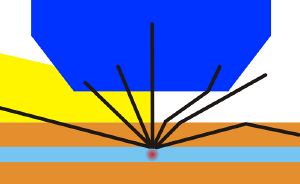(→Tools) |
|||
| Line 23: | Line 23: | ||
*Microscopy with Oil Immersion | *Microscopy with Oil Immersion | ||
''In light microscopy, oil immersion is a technique used to increase the resolving power of a microscope. This is achieved by immersing both the objective lens and the specimen in a transparent oil of high refractive index, thereby increasing the numerical aperture of the objective lens. Immersion oils are transparent oils that have specific optical and viscosity characteristics necessary for use in microscopy.'' | |||
(https://en.wikipedia.org/wiki/Oil_immersion) | |||
*Further read and how to: http://www.micrographia.com/tutoria/micbasic/micbpt07/micb0700.htm | *Further read and how to: http://www.micrographia.com/tutoria/micbasic/micbpt07/micb0700.htm | ||
Revision as of 13:17, 29 December 2018
23.10.2018
Literature
Intro
Ethics
Draft DIY-bio Code for ethics from European congress
- Transparency. Emphasize transparency and the sharing of ideas, knowledge, data and results
- Safety. Adopt safe practices
- Open Access. Promote citizen science and decentralized access to biotechnology.
- Education. Help educate the public about biotechnology, its benefits and implication.
- Modesty. Know, you don’t know everything.
- Community. Carefully listen to any concerns and questions and respond honestly.
- Peaceful Purposes. Biotechnology must only be used for peaceful purposes.
- Respect. Respect humans and all living systems.
- Responsibility. Recognize the complexity and dynamics of living systems and our responsibility towards them.
- Accountability. Remain accountable for your actions and for upholding this code.
Tools
Microscopy

- Microscopy with Oil Immersion
In light microscopy, oil immersion is a technique used to increase the resolving power of a microscope. This is achieved by immersing both the objective lens and the specimen in a transparent oil of high refractive index, thereby increasing the numerical aperture of the objective lens. Immersion oils are transparent oils that have specific optical and viscosity characteristics necessary for use in microscopy. (https://en.wikipedia.org/wiki/Oil_immersion)
- Further read and how to: http://www.micrographia.com/tutoria/micbasic/micbpt07/micb0700.htm
Microscopic Photography
The first step is to find a subject, in my case, I want to work with Polycephalum/physarum an allowed sample in the laboratory and with samples that will be brought by my colleagues.
Types of photography with a microscope:
- Köhler Illumination: neutral and uniform backlighting, helps to maximize the contrast and resolution in the image.
- Darkfield: makes an object glow against a black background by using a darkfield condenser into the microscope (there are to types; dry or oil condenser).
Link to examples in microscopic photography & video work samples.
[[1]]
[[2]]
DIY Microscopy
Electronic Tools
- File:Martin-howse.pdf
- File:Arduino-tutorial-analog.maxpat
- Arduino. https://www.arduino.cc/en/Tutorial/PWM
Tool Kit
References
- My Collaboration with Bacteria for Paper Production [PDF]
- Miya Masaoka, Pieces for Plants, http://www.youtube.com/watch?v=1AHOEcAprc8
- Martin Howse, Radio Mycelium, http://libarynth.org/parn/radio_mycelium
- Laura Popplow, Fungutopia, http://www.fungutopia.org/
- Paul Stamets, Life Box, https://www.youtube.com/watch?v=Q8CMsB4jLLc
- Donna Haraway, Anthropocene, Capitalocene, Plantationocene,
Chthulucene: Making Kin, http://environmentalhumanities.org/arch/vol6/6.7.pdf
- Riedel-Kruse Lab, Biotic games: https://web.stanford.edu/group/riedel-kruse/